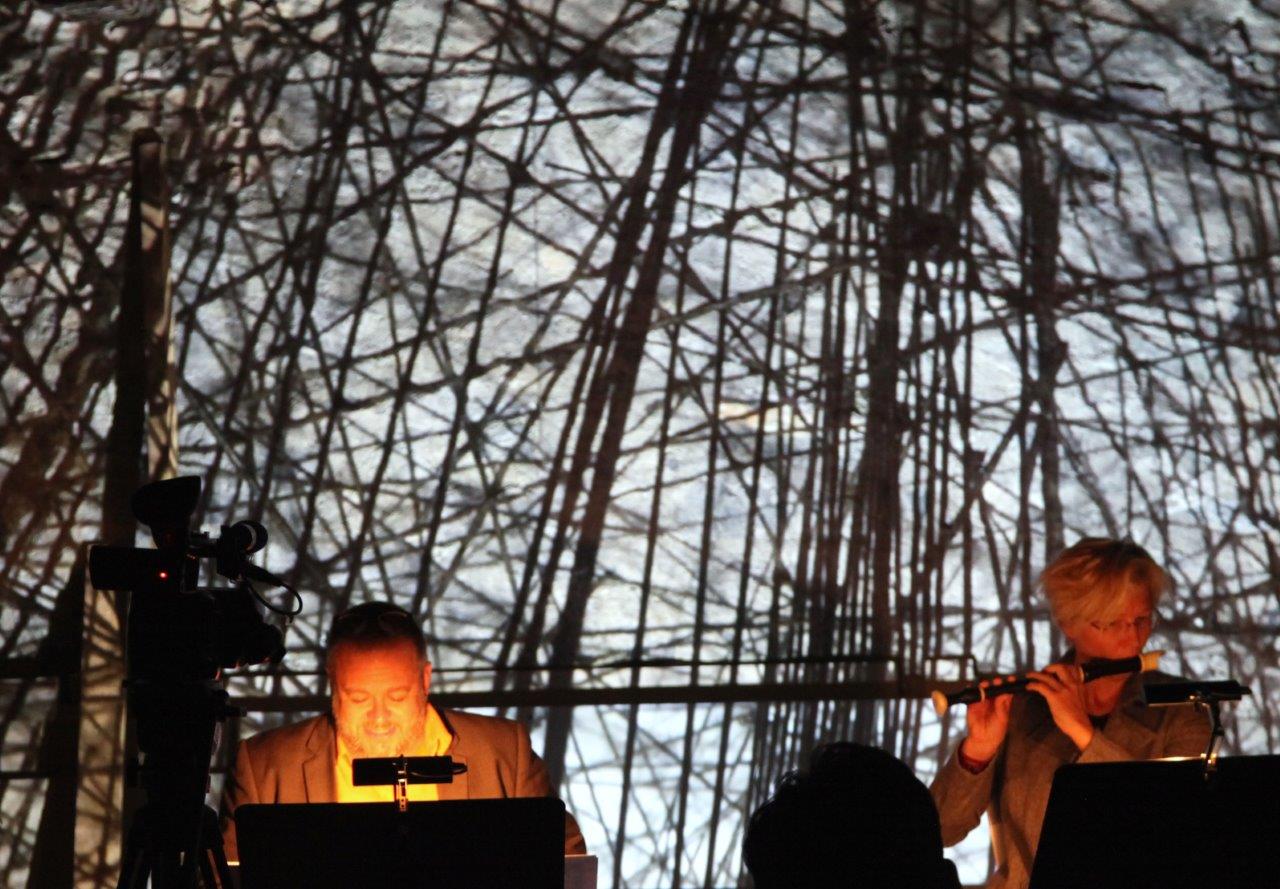|
ANTICIPATED
SCHEDULE!
VORGEZOGENE SPIELZEIT! 3 JUNI 2017 - 20h15 - Schloss Leuk UMS 'n JIP
UMS 'n JIP UMS 'n JIP (Ulrike Mayer-Spohn und Javier Hagen) forschen und arbeiten im Grenzbereich zwischen musikalischer Avantgarde und Pop, zwischen Konzert und Musiktheater, zwischen europäischer und aussereuropäischer Musik und arbeiteten unter anderem mit Komponisten wie Goebbels, Rihm, Eötvös, Reimann, Kagel, Oña, Dayer, Gysin, Huang Ruo, Guo Wenjing und Deqing Wen zusammen. In 10 Jahren über 900 Konzerte auf mittlerweile allen Kontinenten, über 20 internationale Auszeichnungen, darunter das prestigeträchtige Dreijahresstipendium MusiquePRO des Kantons Wallis, 8 Musiktheaterpremieren (wovon 3 am Teatro Colon in Buenos Aires), 2 internationale Forschungsprojekte, Gastvorlesungen an bedeutenden Universitäten der USA, Russlands, Chinas, Hong Kongs, Australiens, Griechenlands, Ägyptens, Spaniens, der Türkei, der Schweiz und Frankreichs sowie ihr Engagement innerhalb der ISCM (Int. Society for Contemporary Music) und der ECPNM (European Conference for Promoters of New Music) sind nur einige Mosaiksteine einer ebenso aussergewöhnlichen wie konsequenten künstlerischen Démarche: Beinahe jedes der über 200 in Auftrag gegebenen Werke ist das meistgespielte Werk des jeweiligen Komponisten. Seit 2011 werden sie musikalisch von einem der bedeutendsten Interpreten für Neue Musik gecoacht: Irvine Arditti (Arditti Quartet London).
PROGRAMM JIP MOTOHARU KAWASHIMA duration: 77min
KOMMENTAR '55 Minutes' is a hybrid that falls between spatial composition, installation and audio-visual performance. It focuses on the content of music and speech cells that through repetition become independent sounds: language and music as a projection on the path from nowhere to nowhere. '55 minutes' by JIP extends by 12 seconds each minute of John Cage's '45' for one speaker', one of the 20th-century's most famous musical and literary compositions, sympathetically translated into German by Ernst Jandl. Noises, language and musical motifs are handled playfully and distributed across three loudspeakers in the room. At the same time, a sprechgesang lecture unfolds in synch and in contrapuntal terms, along with -- again in Cageian style -- two further one-hour-long sound layers: a field recording tape and a five-part piece for recorder, which successively presents the sounds that will appear in the epilogue,'Weeds in Ophelia's Hair' by Rolf Riehm for solo recorder.
ABOUT 45' FOR A SPEAKER BY JOHN CAGE The Time-Length Pieces (by Richard Brown Jr.). In the years 1954 to 1956 John Cage wrote a series of 5 pieces which are all named after their exact lengths: 27’10.554’’ for a percussionist They are all written “in space”, in that there is a timeline (of seconds) indicating which musical action is to be performed when. In his notes to all these pieces, Cage encourages performers to not only play the pieces on their own, but also simultaneously in any combination. When performing them simultaneously players are asked not to engage, by listening to and interacting with each other, in musical interplay - rather, only the sounds should interact, by means of chance encounters. Cage's instructions for "45' for a Speaker" tells the speaker exactly when and how particular sentences and/or phrases should be read so that the lecture finishes in exactly 45 minutes. "Indeterminacy" is a collection of anecdotes from Cage's life and readings, which, as Cage explains in his instructions, are to be read one per minute. To achieve this goal, the speaker must either speed up or slow down, depending on the length of each anecdote. The greatest challenge of musical discourse lies in the relationship to written text and aural experience. We use words to describe a temporal aural experience, but there is really no direct relationship between the two. Metaphor serves to bridge the link between experiences, and oftentimes we resort to discussions of structure and form when describing a piece, leaving the “interpretation” up to the listener. Historical background, likewise, is an easy realm for musical discussion; these are facts about the piece, but not necessarily about the music “itself.” “45’” does contains a fair amount of “facts” in the sense that it describes compositional techniques Cage was interested in at various points, as well as a considerable amount of metaphor via Zen or East Asian heuristics and anecdotes. Equally, “45’” is densely structured; every element of succession and duration was devised according to a complex precompositional rhythmic structure coupled with a strict gamut technique for content. “45’ For a Speaker” was delivered as a lecture in 1954 in conjunction with 34’ 46.776 for Two Pianists. 34’ 46.776 and was (and is) a part of what James Pritchett describes as the “Ten Thousand things” series in the mid 1950s. After completing Williams Mix in 1952, Cage began a new project, which he described: "From time to time ideas come for my next work which as I see it will be a large work which will always be in progress and will never be finished; at the same time any part of it will be able to be performed once I have begun. It will include tape and any other time actions, not excluding violins and whatever else I put my attention to. I will of course write other music than this, but only if required by some outside situation." The collection of works that resulted from this project include two pieces for piano, two for strings, one unfinished work for voice, one for percussion, an unfinished project for magnetic tape, and “45’ For A Speaker.” The most famous work from this series was 26’ 1.1499” for a string player (1955), made famous largely due to the controversial performances by Charlotte Moorman in the 1960s (performances which Cage famously decried as “murderous”). The unifying element of these works is a similar strategy to Cage’s micro-macrocosmic form from his early percussion works. Cage explicitly outlines the method involved in constructing “45’” in the introduction. The performer reads the text in strict clock time following the timing marks on the left margin, loudness is indicated by typographical means, and noises and gestures that are to be performed are indicated in the right margin. Finally, the content of the lecture was decided via a gamut technique. After tossing the coins or using other star chart or constellation chance procedures, Cage went through the following procedure: 1.) speech or silence, 2.) duration, 3.) new material or old, which led to the following two choices, 4.) if old material, from which lecture and from which part, or 6.) if new material, he chose from 32 different subjects. This gave Cage an consistent way to “write through” that he would refine in the coming decades. Once the process is set up, he could return to the writing or composing project with no concern for previous or future content; the act of writing could be set in motion at any given time. This is why Cage explicitly noted in this and many subsequent written works that they may be performed alone or together in any combination, and that segments can be taken separately and performed in any order. This was not an effort to get away from any sense of continuity or provide an example of “pure” indeterminacy, it was merely a mirror of the compositional process employed in creating the pieces themselves. They never really existed in any final form since they were composed with an automated means, and thus their ontological status need not be defined with any sense of totality. Thus “reading through” this work presents another level of circularity central to the Cagean aesthetic. This is in essence a mosaic of ideas and aphorisms related to Cage’s compositional style and various philosophical statements, and the thinking mind inevitably goes about making analytical connections between statements, history, individual pieces, literary theory, art history, musicology, etc.; we cannot stop the thinking mind from thinking, especially when there are hints of ideas that evoke our own personal understanding of Cage’s life and history, our own aesthetic and creative dilemmas, or any other host of ideas that float in and out of the mind in any given setting. To make matters worse, the content of many of these small gamuts of ideas are explicitly involved in describing that very intellectual circularity: we are thinking about what we are thinking about while it happens over time. This is something akin to the phenomenological reduction that attempts to get at the “thing itself,” which, itself, is a central concern of modern philosophy. Phenomenology is more concerned with “essences,” or the fleeting sense of something rather than the concrete, since it is impossible to perceive just what that is in time; it’s sort of like glancing over your shoulder, or the cold feeling of déjà vu. (...) This work has no score. It should be abolished. “A statement concerning the arts is no statement concerning the arts.” It consists of single parts. Any of them may be played together or eliminated and at any time. “To me teaching is an expedient, but I do not teach external signs.” Like a long book if a long book is like a mobile. “The ignorant because of their attachment to existence seize on signified or signifying.” No beginning no ending. Harmony, so called, is a forced abstract vertical relation which blots out the spontaneous transmitting nature of each of the sounds forced into it. Form, then, is not something off in the distance in solitary confinement: It is right here right now. Since it is something we say about past actions, it is wise to drop it. http://www.ayearfrommonday.com/2012/01/45-for-speaker-1954.html
JOHN CAGE (John Milton Cage Jr., September 5, 1912 – August 12, 1992) was an American composer, music theorist, writer, and artist. A pioneer of indeterminacy in music, electroacoustic music, and non-standard use of musical instruments, Cage was one of the leading figures of the post-war avant-garde. Critics have lauded him as one of the most influential American composers of the 20th century. He was also instrumental in the development of modern dance, mostly through his association with choreographer Merce Cunningham, who was also Cage's romantic partner for most of their lives. Cage is perhaps best known for his 1952 composition 4'33'', which is performed in the absence of deliberate sound; musicians who present the work do nothing aside from being present for the duration specified by the title. The content of the composition is not "four minutes and 33 seconds of silence," as is sometimes assumed, but rather the sounds of the environment heard by the audience during performance. The work's challenge to assumed definitions about musicianship and musical experience made it a popular and controversial topic both in musicology and the broader aesthetics of art and performance. Cage was also a pioneer of the prepared piano (a piano with its sound altered by objects placed between or on its strings or hammers), for which he wrote numerous dance-related works and a few concert pieces. The best known of these is Sonatas and Interludes (1946–48). His teachers included Henry Cowell (1933) and Arnold Schoenberg (1933–35), both known for their radical innovations in music, but Cage's major influences lay in various East and South Asian cultures. Through his studies of Indian philosophy and Zen Buddhism in the late 1940s, Cage came to the idea of aleatoric or chance-controlled music, which he started composing in 1951. The I Ching, an ancient Chinese classic text on changing events, became Cage's standard composition tool for the rest of his life. In a 1957 lecture, Experimental Music, he described music as "a purposeless play" which is "an affirmation of life – not an attempt to bring order out of chaos nor to suggest improvements in creation, but simply a way of waking up to the very life we're living". http://en.wikipedia.org/wiki/John_Cage
|
|






